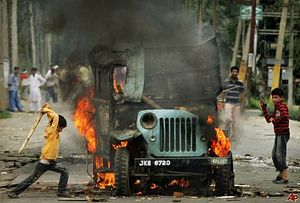In September, War on the Rocks published an interesting article by Ayesha Ray titled “The Case for Revising India’s Counterinsurgency Strategy in Kashmir.” Ayesha’s approach to the conflict in Kashmir realizes the notion that there is limited utility in the forces India provides to fight for “hearts and minds” in the people centric conflict that is Kashmir. However, the Kashmir conflict both embodies a Rupert Smith “war amongst the people” political conflict and a standard international armed conflict between Pakistan and India, which India must balance both.
First, Ayesha points out that India’s force structure has no real utility to address the unique characteristics of a people centric strategy. Though, India set out in the 1990’s to win over “hearts and minds” of the local population, it failed to understand the political aspects of counterinsurgency operations, largely relying on the Rashtriya Rifles, an Indian unit primarily composed of standard infantry to combat rising militant groups.
A heavy handed military presence has done little to quash anti Indian militancy in the region, if anything it has only enflamed tensions between groups seeking autonomy. The killing of Bani Wani, the leader of the terrorist group Hizb-ul-Mujahideen, set of waves of violence, protest, and unrest that resulted in nearly 80 civilian deaths. India’s conventional war mindset in Kashmir blinds it to the political realities causing it to operate with an improper utility of force to combat the underscoring roots of the conflict.
To adequately address rising militancy in the war torn region, India must come to terms with various political realities and realize that force must be balanced with political objectives and other mechanisms to counter violent extremism festering in the region. Some of those mechanisms must include discourse and negotiations with local groups to include separatists, in which Northern Army Commander Lt. Gen. DS Hooda stated the need to maintain “restraint” and “positive engagement” with the people during a visit to Awantipur based Victor Force headquarters in Srinagar, Kashmir.
However, political engagement cannot just be based on fruitless talks, local Kashmiris must see India’s seriousness in reducing tension in the region through economic programs to provide jobs and services to youths that may be swayed to extremist ideologies. Furthermore, India must bolster not undermine Article 370 that grants special autonomy to Jammu and Kashmir, yet maintain a constitutional link to India.
India’s history of impunity in the region must end, that means reforming the Armed Forces Special Powers Act, which has been used by Indian forces to act with immunity while committing serious human rights violations and abusing personal freedoms of local inhabitants in the name of counterterrorism operations.
Ayesha proposes Rupert Smith’s utility of force to properly maximize India’s efforts to quell conflict in the region. That ideal recognizes the core tenet of Rupert Smith’s thesis, that today’s conflicts are timeless and space and time are needed for warring parties to accept various political realities. India’s strategy cannot just focus on military strategy, but must occupy all levels of statecraft to include diplomacy, negotiation, economic assistance, and ideological warfare to combat growing violent extremism in the region. Military forces are generally not equipped properly to engage in these kinds of operations.
However, Ayesha’s proposal illustrates a dichotomy at play in Kashmir, something that Rupert Smith’s thesis fails to address, and that is Kashmir represents a “war amongst the people” waged largely by non-state actors but it is also an international armed conflict between two states, in which deterrence is paramount to avoiding nuclear confrontation between India and Pakistan.
In this aspect India still must maintain a sizeable conventional military force to deter Pakistani aggression in the region. Despite Rupert Smith’s assertion that industrial state warfare has ended, Pakistan and India are entangled in what is known as the stability-instability paradox that is India and Pakistan’s nuclear arsenals make limited war in Kashmir between conventional forces more likely. An example of this engagement was the Kargil war, fought between May and July of 1999, between the two nuclear heavyweights, which saw the use of conventional forces to include airpower, artillery, rockets, mortars, and standard infantry over mountainous terrain.
India’s paradox is that it must maintain a sizeable occupation presence while engaging in force deescalation at a local level in Kashmir. India’s war against Pakistan must be fought on ideological and political terms as well as traditional deterrence; the two cannot be divorced completely. Clausewitz and Rupert Smith are both at play in Kashmir.

































